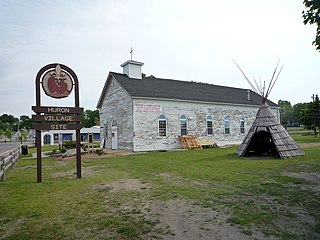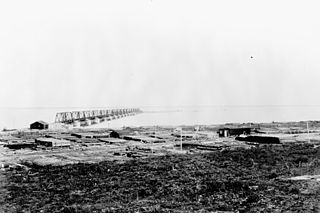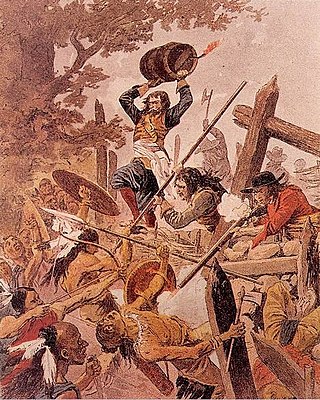Contents
| Part of a series on the |
| History of Canada |
|---|
 |
Research |
Events from the 1650s in Canada.
| Part of a series on the |
| History of Canada |
|---|
 |
Events from the 1650s in Canada.

New France was the territory colonized by France in North America, beginning with the exploration of the Gulf of Saint Lawrence by Jacques Cartier in 1534 and ending with the cession of New France to Great Britain and Spain in 1763 under the Treaty of Paris.

A coureur des bois or coureur de bois were independent entrepreneurial French Canadian traders who travelled in New France and the interior of North America, usually to trade with First Nations peoples by exchanging various European items for furs. Some learned the trades and practices of the indigenous peoples.

Paul de Chomedey de Maisonneuve was a French military officer and the founder of Ville-Marie, now the city of Montreal.

Pierre-Esprit Radisson (1636/1640–1710) was a French coureur des bois and explorer in New France. He is often linked to his brother-in-law Médard des Groseilliers. The decision of Radisson and Groseilliers to enter the English service led to the formation of the Hudson's Bay Company. His career was particularly notable for its repeated transitions between serving Britain and France.
Médard Chouart des Groseilliers was a French explorer and fur trader in Canada. He is often paired with his brother-in-law Pierre-Esprit Radisson, who was about 20 years younger. The pair worked together in fur trading and exploration. Their decision to enter British service led to the foundation of the Hudson's Bay Company in 1670. This company established trading posts and extensive relations with the First Nations in western Canada. It was highly influential in making the region amenable to British colonization. Radisson, with Groseiliers, also mapped many of the Great Lakes and trading routes used by settlers.
The Beaver Wars, also known as the Iroquois Wars or the French and Iroquois Wars, were a series of conflicts fought intermittently during the 17th century in North America throughout the Saint Lawrence River valley in Canada and the Great Lakes region which pitted the Iroquois against the Hurons, northern Algonquians and their French allies. As a result of this conflict, the Iroquois destroyed several confederacies and tribes through warfare: the Hurons or Wendat, Erie, Neutral, Wenro, Petun, Susquehannock, Mohican and northern Algonquins whom they defeated and dispersed, some fleeing to neighbouring peoples and others assimilated, routed, or killed.

This section of the Timeline of Quebec history concerns the events between the foundation of Quebec and establishment of the Sovereign Council.

Events from the 1640s in Canada.

Events from the 1660s in Canada.

Fort de Buade was a French fort in the present U.S. state of Michigan's Upper Peninsula across the Straits of Mackinac from the northern tip of lower Michigan's "mitten". It was garrisoned between 1683 and 1701. The city of St. Ignace developed at the site, which also had the historic St. Ignace Mission founded by Jesuits. The fort was named after New France's governor at the time, Louis de Buade de Frontenac.

Chequamegon Bay is an inlet of Lake Superior in Ashland and Bayfield counties in the extreme northern part of Wisconsin.
Jérôme Lalemant, S.J. was a French Jesuit priest who was a leader of the Jesuit mission in New France.

Port Nelson is a ghost town on Hudson Bay, in Manitoba, Canada, at the mouth of the Nelson River. Its peak population in the early 20th century was about 1,000 people. Immediately to the south-southeast is the mouth of the Hayes River and the settlement of York Factory. Some books use 'Port Nelson' to mean the region around the mouths of the two rivers.

The Battle of Long Sault occurred over a five-day period in early May 1660 during the Beaver Wars. It was fought between French colonial militia, with their Huron and Algonquin allies, against the Iroquois Confederacy.

The Lachine massacre, part of the Beaver Wars, occurred when 1,500 Mohawk warriors launched a surprise attack against the small settlement of Lachine, New France, at the upper end of Montreal Island, on the morning of 5 August 1689.
Canaqueese was a Mohawk war leader and diplomat who lived in the 17th century in the Mohawk Valley in what is now New York State. He was of mixed heritage with a Mohawk mother and a Dutch father, but was raised and identified as Mohawk. He became an important intermediary between the French, the Dutch and the Mohawk during the intermittent conflicts known as the Beaver Wars which arose over control of the fur trade. Canaqueese participated in several attempts to reach a peace agreement between the Mohawk and New France but always acted to protect the interests of the Mohawk.

The Pays d'en Haut was a territory of New France covering the regions of North America located west of Montreal. The vast territory included most of the Great Lakes region, expanding west and south over time into the North American continent as the French had explored. The Pays d'en Haut was established in 1610 and depended on the colony of Canada until 1763, when the Treaty of Paris ended New France, and both were ceded to the British as the Province of Quebec.

Fort Ville-Marie was a French fortress and settlement established in May 1642 by a company of French settlers, led by Paul de Chomedey de Maisonneuve, on the Island of Montreal in the Saint Lawrence River at the confluence of the Ottawa River, in what is today the province of Quebec, Canada. Its name is French for "City of Mary", a reference to the Blessed Virgin Mary.
Louis Chartier was a surgeon sent to Canada from France in 1653. He was part of an initiative which was to strengthen Montreal. The Société Notre-Dame de Montréal, who were responsible for founding Ville-Marie, had pledged to provide free medical care for the settlers. One of his companions in this endeavour was Étienne Bouchard, another surgeon.